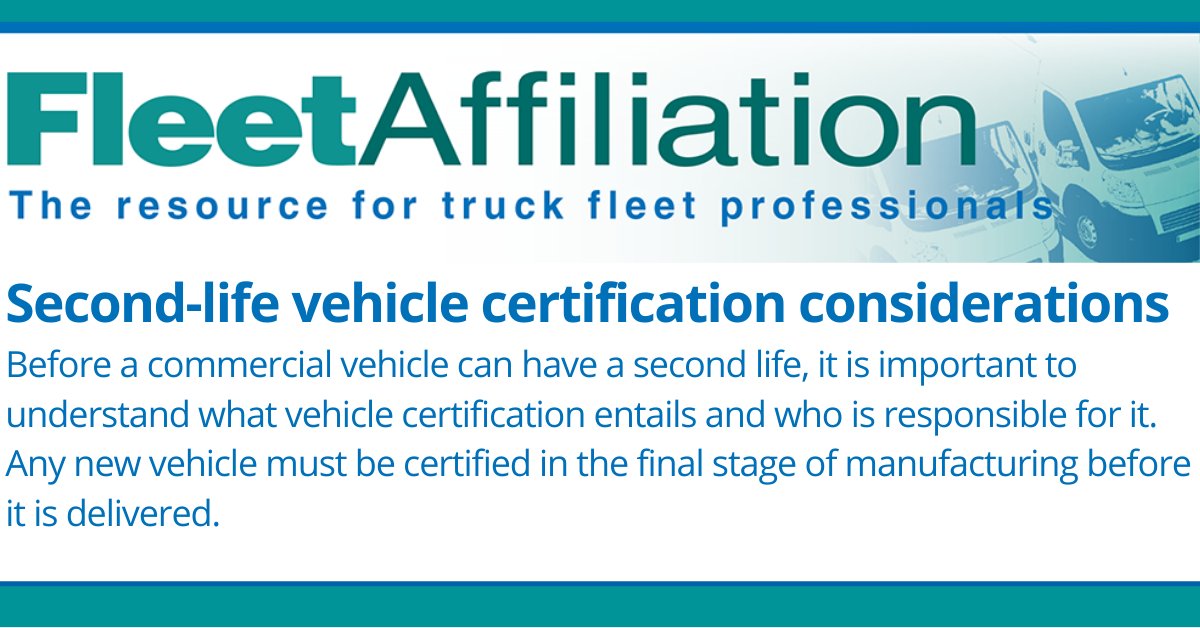Second-life vehicle certification considerations

Published in May 2024 Fleet Affiliation.
Commercial vehicles carry a much longer service life than off-the-shelf, mass-produced vehicles and are often repurposed, rebuilt and even re-upfitted. This can occur with the original owning organization, or it could be done as a retrofit on the used vehicle market. Several questions centered around vehicle certification gross vehicle weight ratings (GVWR) and gross axle weight ratings (GAWR) are commonly asked by fleets considering giving vehicles a second life.
Taking a step back
Before a commercial vehicle can have a second life, it’s important to understand what vehicle certification entails and who is responsible for it. Any new vehicle must be certified in the final stage of manufacturing before it is delivered. The manufacturer must certify that a vehicle conforms to all applicable Federal Motor Vehicle Safety Standards (FMVSS) before it can be sold in the U.S. Similarly, Canada has comparable requirements through the Canadian Motor Vehicle Safety Standards (CMVSS).
For mass-produced vehicles such as cars, vans or light pickup trucks, the certification process is fairly straightforward, as these units are typically manufactured and sold as complete vehicles by a single manufacturer. However, the process becomes more complex for commercial vehicles. These vehicles often leave the original equipment manufacturer (OEM) as incomplete vehicles and undergo further manufacturing and upfitting before being certified as completed vehicles.
The manufacturer (i.e., upfitter) who completes the vehicle to the point where it complies with all F/CMVSS is considered the final-stage manufacturer.
When does certification end?
Certification responsibilities, including labeling, end with the completed vehicle's (including certification in the final stage) first retail sale (i.e., licensed and titled in a U.S. state or delivered to a purchaser at the first retail level in a province or territory in Canada). However, this does not negate liability when fleets perform their own modifications. Common scenarios include fleets purchasing and licensing a vehicle before adding equipment or performing modifications. This could also include upfitting a purchased used chassis.
Similarly, if a fleet purchases a completed van, licenses and titles the vehicle, and then installs interior shelves, they would not be required to certify the vehicle and attach the altered certification label. However, that fleet is still responsible for ensuring the van remains in regulatory compliance to both FMVSS and EPA requirements.
GVWR and used chassis
Another common theme involves GVWR and GAWR rerating. Answers to these queries can be long and complicated. In essence, the GVWR and GAWRs represent the maximum weights that the fully assembled vehicle and each of its axles can support while still adhering to regulatory standards and meeting durability and OEM warranty goals. Once a vehicle is certified in the final stage and subsequently goes through the first retail sale process as noted previously, the certification process ends and GVWR/GAWRs cannot be changed. With that, it’s important to understand the implications of upfitting or asking your upfitter to add or change equipment on used vehicles.
